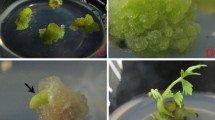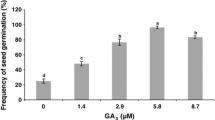Abstract
Plant regeneration via adventitious shoot organogenesis from callus cultures initiated from mature embryos in white pine (Pinus strobus L.) was achieved in this study. Callus cultures were induced from mature embryos cultured on PS medium supplemented with 2,4-dichlorophenoxyacetic acid, α-naphthaleneacetic acid, or indole-3-acetic acid. Adventitious shoot regeneration from callus cultures was induced on medium containing 2 μM indole-3-butyric acid (IBA) and 3–12 μM N6-benzylaminopurine, thidiazuron (TDZ), or 6-(γ,γ-dimethylallylamino) purine. Sucrose was the most suitable sugar for adventitious shoot organogenesis in white pine. Shoot organogenesis was improved by treatment at 4°C for 6 weeks. The frequency of adventitious shoot formation increased when 0.1 mM putrescine was added to basal medium supplemented with 6 μM TDZ and 2 μM IBA. Putrescine improved adventitious shoot organogenesis by decreasing lipid peroxidation. These findings provide useful information on adventitious shoot organogenesis and may be valuable to genetic transformation in white pine.



Similar content being viewed by others
Abbreviations
- BA:
-
N6-Benzylaminopurine
- 2,4-D:
-
2,4-Dichlorophenoxyacetic acid
- CH:
-
Casein enzymatic hydrosylate
- IAA:
-
Indole-3-acetic acid
- 2iP:
-
6-(γ,γDimethylallylamino) purine
- IBA:
-
Indole-3-butyric acid
- NAA:
-
α-Naphthaleneacetic acid
- TDZ:
-
Thidiazuron (N-phenyl-N′-1,2,3-thidiazol-5-ylurea)
References
Ammirato PV (1983) Embryogenesis. In: Evans DA, Sharp WR, Ammirato PV, Yamada Y (eds) Handbook of plant cell culture, vol 1. MacMillan, New York, pp 82–123
Attree SM, Fowke LC (1993) Embryogeny of gymnosperms: advances in synthetic seed technology of conifers. Plant Cell Tissue Organ Cult 35:1–35
Bilkey PC, Cocking EC (1981) Increased plant vigor by in vitro propagation of Saintpaulia ionantha Wendl. from sub-epidermal tissue. HortScience 16:643–644
Bonga JM, Von Aderkas P (1992) In vitro culture of trees. Kluwer, Dordrecht
Brand MH, Lineberger RD (1992) Micropropagation of American sweetgum (Liquidamber styraciflua L.). In: Bajaj YPS (ed) Biotechnology in agriculture and forestry, vol 18. High tech and micropropagation, 2. Springer, Berlin Heidelberg New York, pp 3–24
Burritt DJ, Leung DWM (1996) Organogenesis in cultured petiole explants of Begonia erythrophylla: the timing and specificity of the inductive stimuli. J Exp Bot 47:557–567
Find J, Grace L, Krogstrup P (2002) Effect of anti-auxins on maturation of embryogenic tissue cultures of Nordmanns fir (Abies nordmanniana). Physiol Plant 116:231–237
Fiola JA, Hassan MA, Swartz HJ, Bors RH, McNicols R (1990) Effects of thidiazuron, light fluence rates and kanamycin on in vitro shoot organogenesis from excised Rubus cotyledons and leaves. Plant Cell Tissue Organ Cult 20:223–228
Flick CE, Evans DA, Sharp WR (1983) Organogenesis. In: Evans DA, Sharp WR, Ammirato PV, Yamada Y (eds) Handbook of plant cell culture, vol I. MacMillan, New York, pp 13–81
Fujimura T, Komamine A (1979) Involvement of endogenous auxin in somatic embryogenesis in a carrot suspension culture. Z Pflanzenphysiol 115:371–387
Gaspar T, Kevers C, Penel C, Greppin H, Reid DM, Thorpe TA (1996) Plant hormones and plant growth regulators in plant tissue culture. In Vitro Cell Dev Biol 32:272–289
George MW, Tripepi RR (1994) Cytokinins, donor plants and time in culture affect shoot regenerative capacity of American elm leaves. Plant Cell Tissue Organ Cult 39:27–36
Guevin TG, Kirby EG (1997) Induction of embryogenesis in cultured mature zygotic embryos of Abies fraseri (Pursh) Poir. Plant Cell Tissue Organ Cult 49:219–222
Harney PM, Knop A (1979) A technique for the in vitro propagation of African violets using petioles. Can J Plant Sci 59:263–266
Heath RL, Packer L (1968) Photoperoxidation in isolated chloroplasts. I. Kinetics and stoichiometry of fatty acid peroxidation. Arch Biochem Biophys 125:189–198
Hutchinson MJ, Murch SJ, Saxena PK (1996) Morphoregulatory role of TDZ: evidence of the involvement of endogenous auxin in TDZ-induced somatic embryogenesis of geranium (Pelargonium × hortorum Bailey). J Plant Physiol 149:573–579
Jalonen P, von Arnold S (1991) Characterization of embryogenic cell lines of Picea abies in relation to their competence for maturation. Plant Cell Rep 10:384–387
Kaneda Y, Tabei Y, Nishimura S, Harada K, Akihama T, Kitamura K (1997) Combination of thidiazuron and basal media with low salt concentrations increases the frequency of shoot organogenesis in soybeans [Glycine max (L.) Merr.]. Plant Cell Rep 17:8–12
Klimaszewska K, Bernier-Cardou M, Cyr DR, Sutton BCS (2000) Influence of gelling agents on culture medium gel strength, water availability, tissue water potential, and maturation response in embryogenic cultures of Pinus strobus L. In Vitro Cell Dev Biol Plant 36:279–286
Low RK, Prakash AP, Swarup S, Goh C-J, Kumar PP (2001) A differentially expressed bZIPgene is associated with adventitious shoot regeneration in leaf cultures of Paulownia kawakamii. Plant Cell Rep 20:696–700
Malik KA, Saxena PK (1992) Thidiazuron induces high frequency shoot regeneration in intact seedlings of pea (Pisum sativum), chickpea (Cicer arietinum) and lentil (Lens culinaris). Aust J Plant Physiol 19:731–740
Mengel K, Kirkby EA (2001) Principles of plant nutrition, 5th edn. Kluwer, Dordrecht
Mithila J, Hall JC, Victor JMR, Saxena PK (2003) Thidiazuron induces shoot organogenesis at low concentrations and somatic embryogenesis at high concentrations on leaf and petiole explants of African violet (Saintpaulia ionantha Wendl.). Plant Cell Rep 21:408–414
Murch SJ, Victor JMR, Krishnaraj S, Saxena PK (1999) The role of proline in thidiazuron-induced somatic embryogenesis of peanut. In Vitro Cell Dev Biol Plant 35:102–105
Murthy BNS, Murch SJ, Saxena PK (1995) Thidiazuron induced somatic embryogenesis in intact seedlings of peanut (Arachis hypogaea L.): endogenous growth regulator levels and significance of cotyledons. Physiol Plant 94:268–276
Murthy BNS, Murch SJ, Saxena PK (1998) Thidiazuron: a potent regulator of in vitro plant morphogenesis. In Vitro Cell Dev Biol Plant 34:267–275
Ochatt SJ, Pontecaille C, Rancillac M (2000) The growth regulators used for bud regeneration and shoot rooting affect the competence for flowering and seed set in regenerated plants of protein peas. In Vitro Cell Dev Biol Plant 36:188–193
Pan ZG, Liu CZ, Murch SJ, El-Demerdash M, Saxena PK (2003) Plant regeneration from mesophyll protoplasts of the Egyptian medicinal plants Artemisia judaica L. and Echinops spinosissimus Turra. Plant Sci 165:681–687
Pospíšilová J, Synková H, Rulcová J (2000) Cytokinins and water stress. Biol Plant 43:321–328
Ramage CM, Williams RR (2003) Mineral uptake in tobacco leaf discs during different developmental stages of shoot organogenesis. Plant Cell Rep 21:1047–1053
Ramage CM, Williams RR (2004) Cytokinin-induced abnormal shoot organogenesis is associated with elevated Knotted1-type homeobox gene expression in tobacco. Plant Cell Rep 22:919–924
Schmülling T, Schafer S, Romanov G (1997) Cytokinins as regulators of gene expression. Physiol Plant 100:505–519
Tang W (2000) Peroxidase activity of desiccation-tolerant loblolly pine somatic embryos. In Vitro Cell Dev Biol Plant 36:488–491
Tang W, Guo Z, Ouyang F (2001) Plant regeneration from embryogenic cultures initiated from mature loblolly pine zygotic embryos. In Vitro Cell Dev Biol Plant 37:558–563
Tang W, Newton RJ (2003) Genetic transformation of conifers and its application in forest biotechnology. Plant Cell Rep 22:1–15
Tang W, Harris LC, Outhavong V, Newton RJ (2004) Antioxidants enhance in vitro plant regeneration by inhibiting the accumulation of peroxidase in Virginia pine (Pinus virginiana Mill.). Plant Cell Rep 22:871–877
Torelli A, Borinato M, Soragni E, Bolpagni R, Bottura C, Branca C (2004) The delay in hormonal treatment modulates the expression of LESK1, a gene encoding a putative serine-threonine kinase, marker of in vitro caulogenesis in tomato (Lycopersicon esculentum Mill.). Plant Sci 167:607–620
Vazquez AM, Davey MR, Short KC (1977) Organogenesis in cultures of Saintpaulia ionantha. Acta Hortic 78:249–259
Vookova B, Kormutak A (2002) Some features of somatic embryo maturation of Algerian fir. In Vitro Cell Dev Biol Plant 38:549–551
Williams GE, Maheswaran G (1986) Somatic embryogenesis: factors influencing coordinated behaviour of cells as an embryogenic group. Ann Bot 57:443–462
Yancheva SD, Golubowicz S, Fisher E, Lev-Yadun S, Flaishman MA (2003) Auxin type and timing of application determine the activation of the developmental program during in vitro organogenesis in apple. Plant Sci 165:299–309
Acknowledgements
The authors are grateful to Nicki Whitley, Nicole Bloom, Tinya DelaGarza, Ambrosia Yarn, and Lonnie Gonsalves for their support in isolating mature embryos from seeds for this study.
Author information
Authors and Affiliations
Corresponding author
Additional information
Communicated by P.P. Kumar
Rights and permissions
About this article
Cite this article
Tang, W., Newton, R.J. Plant regeneration from callus cultures derived from mature zygotic embryos in white pine (Pinus strobus L.). Plant Cell Rep 24, 1–9 (2005). https://doi.org/10.1007/s00299-005-0914-3
Received:
Revised:
Accepted:
Published:
Issue Date:
DOI: https://doi.org/10.1007/s00299-005-0914-3




